Experimental Assessment of RANS Models for Wind Load Estimation over Solar-Panel Arrays
Abstract
1. Introduction
2. Experimental Set-Up
3. Numerical Model
 ); SST k- (
); SST k- ( ); transition SST (
); transition SST ( ); and RSM (▪▪▪▪▪▪▪).
); and RSM (▪▪▪▪▪▪▪).4. Results
4.1. Mean Velocity Field
4.2. Pressure Distribution
4.3. Turbulence Kinetic Energy k
5. Conclusions
Author Contributions
Funding
Acknowledgments
Conflicts of Interest
Nomenclature
| c | panel-chord length |
| chord Reynolds number | |
| k | turbulent kinetic energy |
| turbulent dissipation rate | |
| specific turbulent dissipation rate | |
| LES | large-eddy simulation |
| PIV | particle image velocimetry |
| POD | proper orthogonal decomposition |
| RANS | Reynolds-averaged Navier–Stokes |
| SST | shear stress transport |
| pressure coefficient |
References
- ASCE. Minimum Design Loads for Buildings and Other Structures (ANSI/ASCE 7-93); American Society of Civil Engineers: Reston, VA, USA, 1994. [Google Scholar]
- Timilsina, G.R.; Kurdgelashvili, L.; Narbel, P.A. Solar energy: Markets, economics and policies. Renew. Sust. Energ. Rev. 2012, 16, 449–465. [Google Scholar] [CrossRef]
- Geyer, M.; Lüpfert, E.; Osuna, R.; Esteban, A.; Schiel, W.; Schweitzer, A.; Zarza, E.; Nava, P.; Langenkamp, J.; Mandelberg, E. EUROTROUGH-Parabolic trough collector developed for cost efficient solar power generation. In Proceedings of the 11th International Symposium on Concentrating Solar Power and Chemical Energy Technologies, Zurich, Switzerland, 4–6 September 2002. [Google Scholar]
- Karin, T.; Jones, C.B.; Jain, A. Photovoltaic Degradation Climate Zones. In Proceedings of the IEEE 46th Photovoltaic Specialists Conference, Chicago, IL, USA, 16–21 June 2019; pp. 687–694. [Google Scholar]
- Dunlop, E.D.; Halton, D. The performance of crystalline silicon photovoltaic solar modules after 22 years of continuous outdoor exposure. Prog. Photovoltaics 2006, 14, 53–64. [Google Scholar] [CrossRef]
- Skoczek, A.; Sample, T.; Dunlop, E.D. The results of performance measurements of field-aged crystalline silicon photovoltaic modules. Prog. Photovoltaics 2009, 17, 227–240. [Google Scholar] [CrossRef]
- Poulek, V.; Šafránková, J.; Černá, L.; Libra, M.; Beránek, V.; Finsterle, T.; Hrzina, P. PV Panel and PV Inverter Damages Caused by Combination of Edge Delamination, Water Penetration, and High String Voltage in Moderate Climate. IEEE J. Photovolt. 2021. [Google Scholar] [CrossRef]
- Stenabaugh, S.E.; Iida, Y.; Kopp, G.A.; Karava, P. Wind loads on photovoltaic arrays mounted parallel to sloped roofs on low-rise buildings. J. Wind Eng. Ind. Aerod. 2015, 139, 16–26. [Google Scholar] [CrossRef]
- Naeiji, A.; Raji, F.; Zisis, I. Wind loads on residential scale rooftop photovoltaic panels. J. Wind Eng. Ind. Aerod. 2017, 168, 228–246. [Google Scholar] [CrossRef]
- Chu, C.R.; Tsao, S.J. Aerodynamic loading of solar trackers on flat-roofed buildings. J. Wind Eng. Ind. Aerod. 2018, 175, 202–212. [Google Scholar] [CrossRef]
- Wang, J.; Yang, Q.; Tamura, Y. Effects of building parameters on wind loads on flat-roof-mounted solar arrays. J. Wind Eng. Ind. Aerod. 2018, 174, 210–224. [Google Scholar] [CrossRef]
- Bitsuamlak, G.T.; Dagnew, A.K.; Erwin, J. Evaluation of wind loads on solar panel modules using CFD. In Proceedings of the Fifth International Symposium on Computational Wind Engineering, Chapel Hill, NC, USA, 23–27 May 2010. [Google Scholar]
- Shademan, M.; Hangan, H. Wind loading on solar panels at different azimuthal and inclination angles. In Proceedings of the Fifth International Symposium on Computational Wind Engineering, Chapel Hill, NC, USA, 23–27 May 2010. [Google Scholar]
- Shademan, M.; Barron, R.; Balachandar, R.; Hangan, H. Numerical simulation of wind loading on ground-mounted solar panels at different flow configurations. Can. J. Civ. Eng. 2014, 41, 728–738. [Google Scholar] [CrossRef]
- Jubayer, C.M.; Hangan, H. A numerical approach to the investigation of wind loading on an array of ground mounted solar photovoltaic (PV) panels. J. Wind Eng. Ind. Aerod. 2016, 153, 60–70. [Google Scholar] [CrossRef]
- Reina, G.P.; De Stefano, G. Computational evaluation of wind loads on sun-tracking ground-mounted photovoltaic panel arrays. J. Wind Eng. Ind. Aerod. 2017, 170, 283–293. [Google Scholar] [CrossRef]
- Chevalier, H.; Norton, D. Wind Loads on Solar Collector Panels and Support Structure; Technical report; Department of Aerospace Engineering, Texas A&M University: College Station, TX, USA, 1979. [Google Scholar]
- Abiola-Ogedengbe, A.; Hangan, H.; Siddiqui, K. Experimental investigation of wind effects on a standalone photovoltaic (PV) module. Renew. Energy 2015, 78, 657–665. [Google Scholar] [CrossRef]
- García, E.T.; Ogueta-Gutiérrez, M.; Ávila, S.; Franchini, S.; Herrera, E.; Meseguer, J. On the effects of windbreaks on the aerodynamic loads over parabolic solar troughs. Appl. Energ. 2014, 115, 293–300. [Google Scholar] [CrossRef]
- Etyemezian, V.; Nikolich, G.; Gillies, J. Mean flow through utility scale solar facilities and preliminary insights on dust impacts. J. Wind Eng. Ind. Aerod. 2017, 162, 45–56. [Google Scholar] [CrossRef]
- Bush, R.H.; Chyczewski, T.S.; Duraisamy, K.; Eisfeld, B.; Rumsey, C.L.; Smith, B.R. Recommendations for future efforts in rans modeling and simulation. In Proceedings of the AIAA Scitech 2019 Forum, San Diego, CA, USA, 7–11 January 2019; p. 317. [Google Scholar]
- Menter, F.R. Zonal two equation k-ω turbulence models for aerodynamic flows. In Proceedings of the 23rd Fluid Dynamics, Plasmadynamics, and Lasers Conference, Orlando, FL, USA, 6–9 July 1993; p. 2906. [Google Scholar]
- Menter, F.R. Two-equation eddy-viscosity turbulence models for engineering applications. AIAA J. 1994, 32, 1598–1605. [Google Scholar] [CrossRef]
- Menter, F.; Kuntz, M.; Langtry, R. Ten years of industrial experience with the SST turbulence model. Turbul. Heat Mass Transf. 2003, 4, 625–632. [Google Scholar]
- Blocken, B.; van der Hout, A.; Dekker, J.; Weiler, O. CFD simulation of wind flow over natural complex terrain: Case study with validation by field measurements for Ria de Ferrol, Galicia, Spain. J. Wind Eng. Ind. Aerod. 2015, 147, 43–57. [Google Scholar] [CrossRef]
- Catalano, P.; Wang, M.; Iaccarino, G.; Moin, P. Numerical simulation of the flow around a circular cylinder at high Reynolds numbers. Int. J. Heat Fluid Flow 2003, 24, 463–469. [Google Scholar] [CrossRef]
- Mendez, M.; Raiola, M.; Masullo, A.; Discetti, S.; Ianiro, A.; Theunissen, R.; Buchlin, J.M. POD-based background removal for particle image velocimetry. Exp. Therm. Fluid Sci. 2017, 80, 181–192. [Google Scholar] [CrossRef]
- Astarita, T.; Cardone, G. Analysis of interpolation schemes for image deformation methods in PIV. Exp. Fluids 2005, 38, 233–243. [Google Scholar] [CrossRef]
- Astarita, T. Analysis of weighting windows for image deformation methods in PIV. Exp. Fluids 2007, 43, 859–872. [Google Scholar] [CrossRef]
- Westerweel, J.; Scarano, F. Universal outlier detection for PIV data. Exp. Fluids 2005, 39, 1096–1100. [Google Scholar] [CrossRef]
- Westerweel, J. Fundamentals of digital particle image velocimetry. Meas. Sci. Technol. 1997, 8, 1379. [Google Scholar] [CrossRef]
- Launder, B.E.; Spalding, D.B. The numerical computation of turbulent flows. Comput. Methods Appl. Mech. Eng. 2014, 3, 269–289. [Google Scholar] [CrossRef]
- Galindo, J.; Hoyas, S.; Fajardo, P.; Navarro, R. Set-up analysis and optimization of CFD simulations for radial turbines. Eng. Appl. Comput. Fluid Mech. 2013, 7, 441–460. [Google Scholar] [CrossRef]
- Wilcox, D.C. Reassessment of the scale-determining equation for advanced turbulence models. AIAA J. 1988, 26, 1299–1310. [Google Scholar] [CrossRef]
- Menter, F.R.; Langtry, R.; Likki, S.; Suzen, Y.; Huang, P.; Völker, S. A correlation-based transition model using local variables—Part I: Model formulation. J. Turbomach. 2006, 128, 413–422. [Google Scholar] [CrossRef]
- Craft, T.; Launder, B.; Suga, K. Development and application of a cubic eddy-viscosity model of turbulence. Int. J. Heat Fluid Fl. 1996, 17, 108–115. [Google Scholar] [CrossRef]
- Launder, B.E.; Reece, G.J.; Rodi, W. Progress in the development of a Reynolds-stress turbulence closure. J. Fluid Mech. 1975, 68, 537–566. [Google Scholar] [CrossRef]
- Chou, P.Y. On velocity correlations and the solutions of the equations of turbulent fluctuation. Q. Appl. Math. 1945, 3, 38–54. [Google Scholar] [CrossRef]
- Rotta, J. Statistische theorie nichthomogener turbulenz. Z. Phys. 1951, 129, 547–572. [Google Scholar] [CrossRef]
- Durbin, P. On the k-ε stagnation point anomaly. Int. J. Heat Fluid Flow 1996, 17, 9–90. [Google Scholar] [CrossRef]
- De Stefano, G.; Vasilyev, O.V.; Brown-Dymkoski, E. Wavelet-based adaptive unsteady Reynolds-averaged turbulence modelling of external flows. J. Fluid Mech. 2018, 837, 765–787. [Google Scholar] [CrossRef]
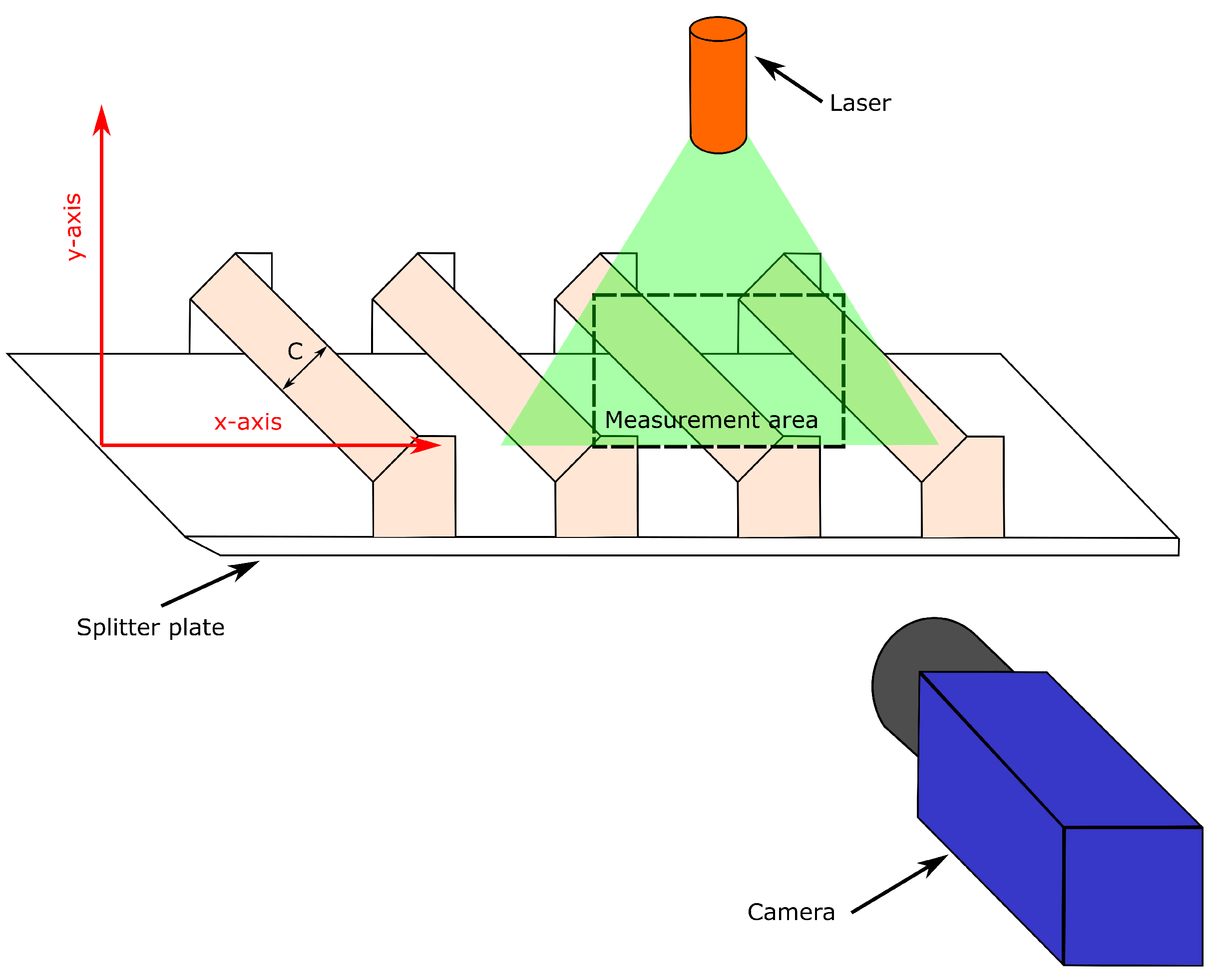
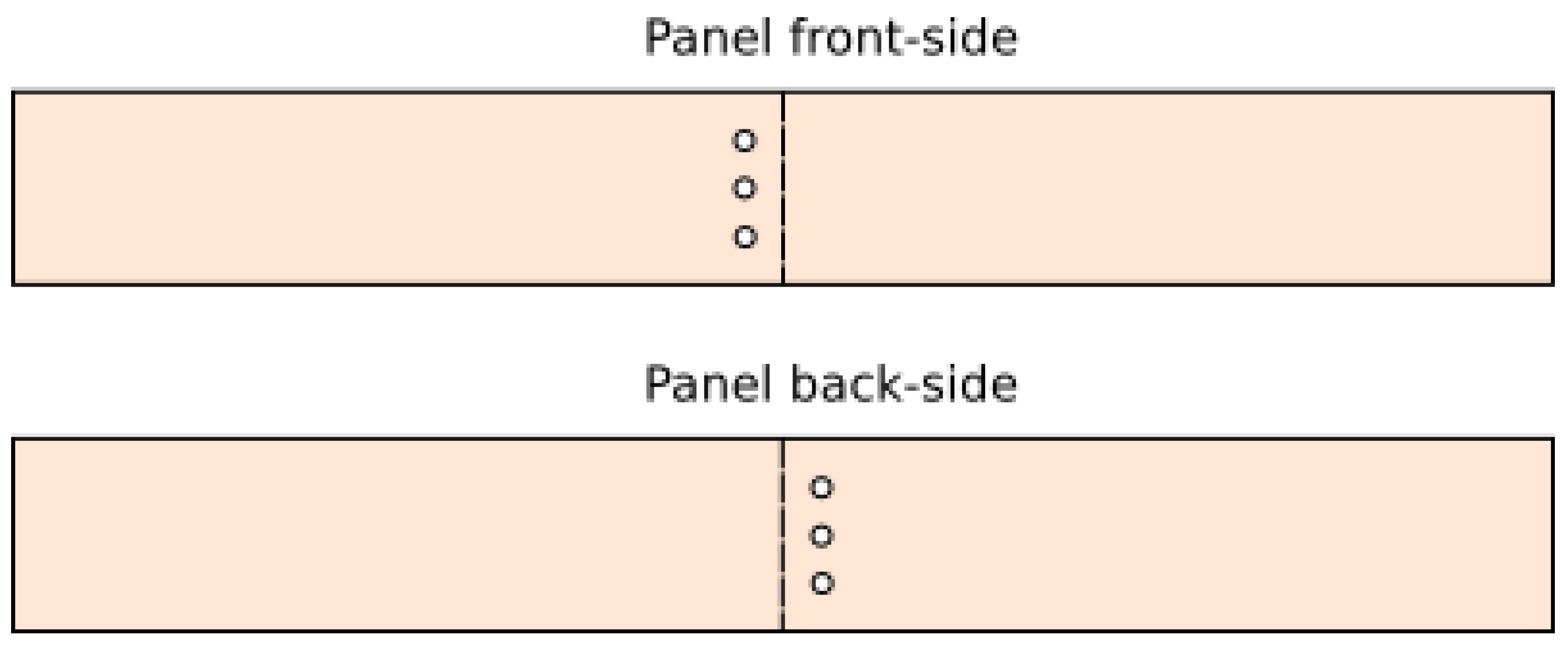
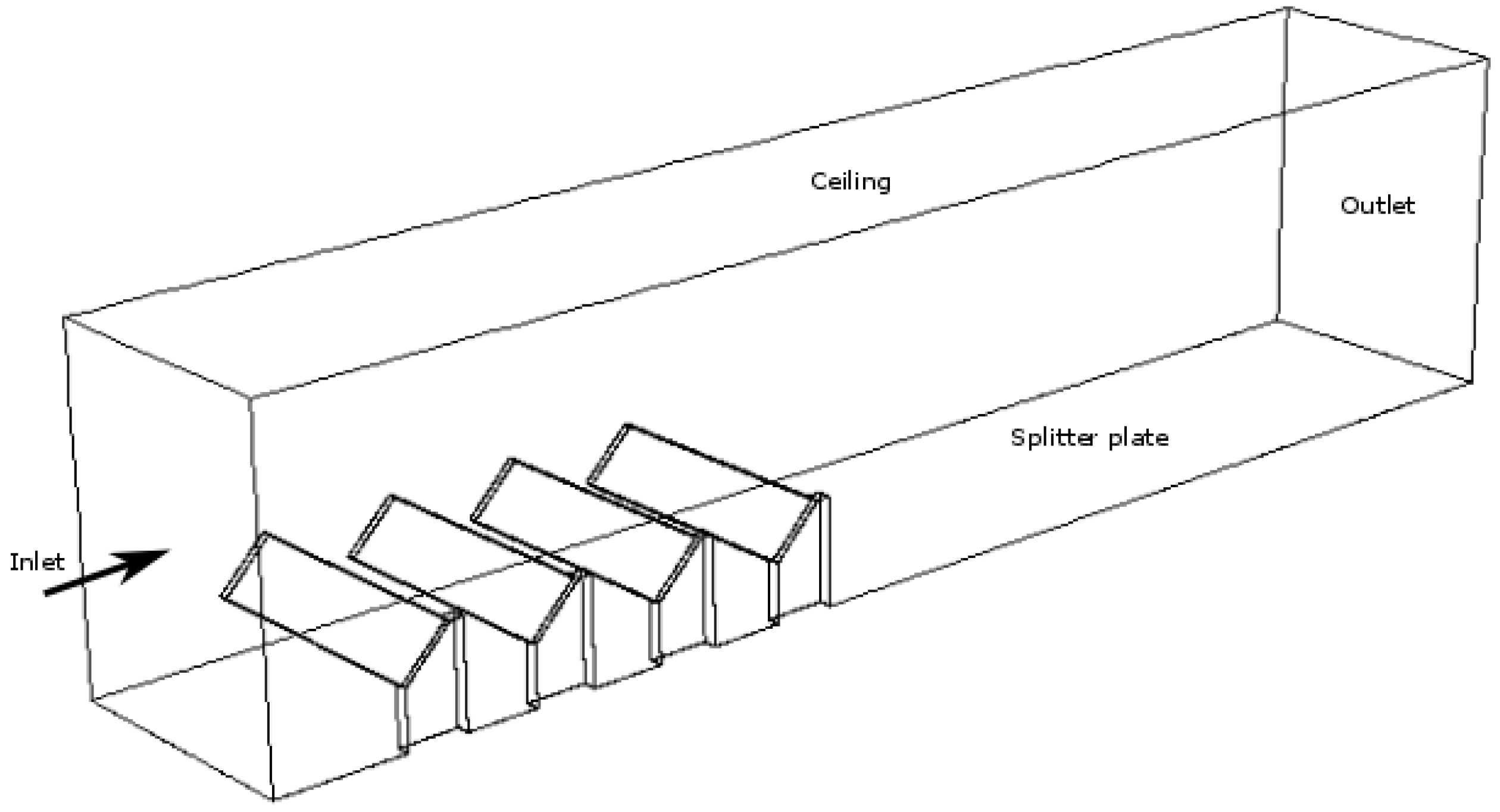
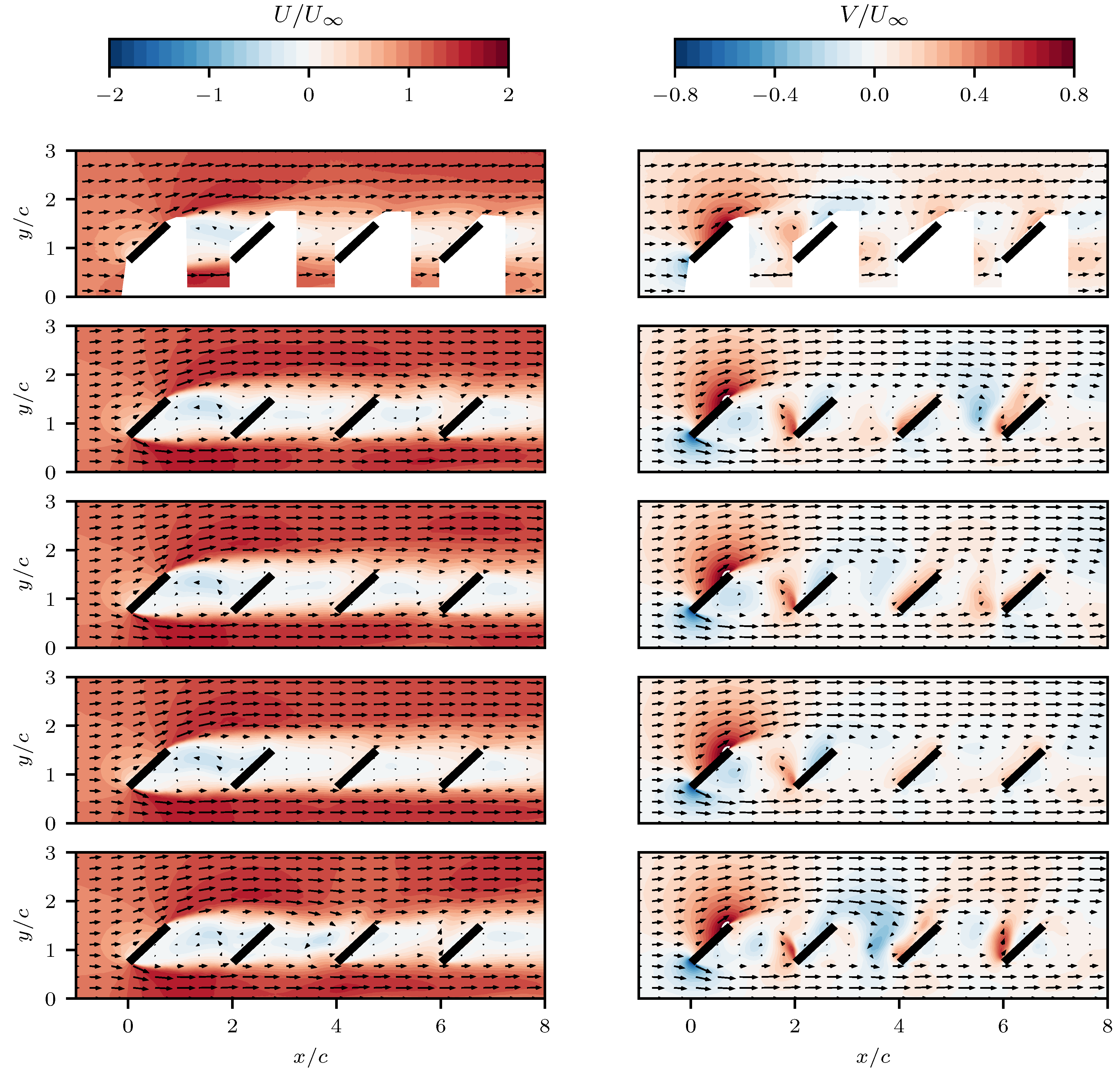
 ); SST k- (
); SST k- ( ); transition SST (
); transition SST ( ); and RSM (▪▪▪▪▪▪▪). Experimental measurements are shown as (◦).
); and RSM (▪▪▪▪▪▪▪). Experimental measurements are shown as (◦).
 ); SST k- (
); SST k- ( ); transition SST (
); transition SST ( ); and RSM (▪▪▪▪▪▪▪). Experimental measurements are shown as (◦).
); and RSM (▪▪▪▪▪▪▪). Experimental measurements are shown as (◦).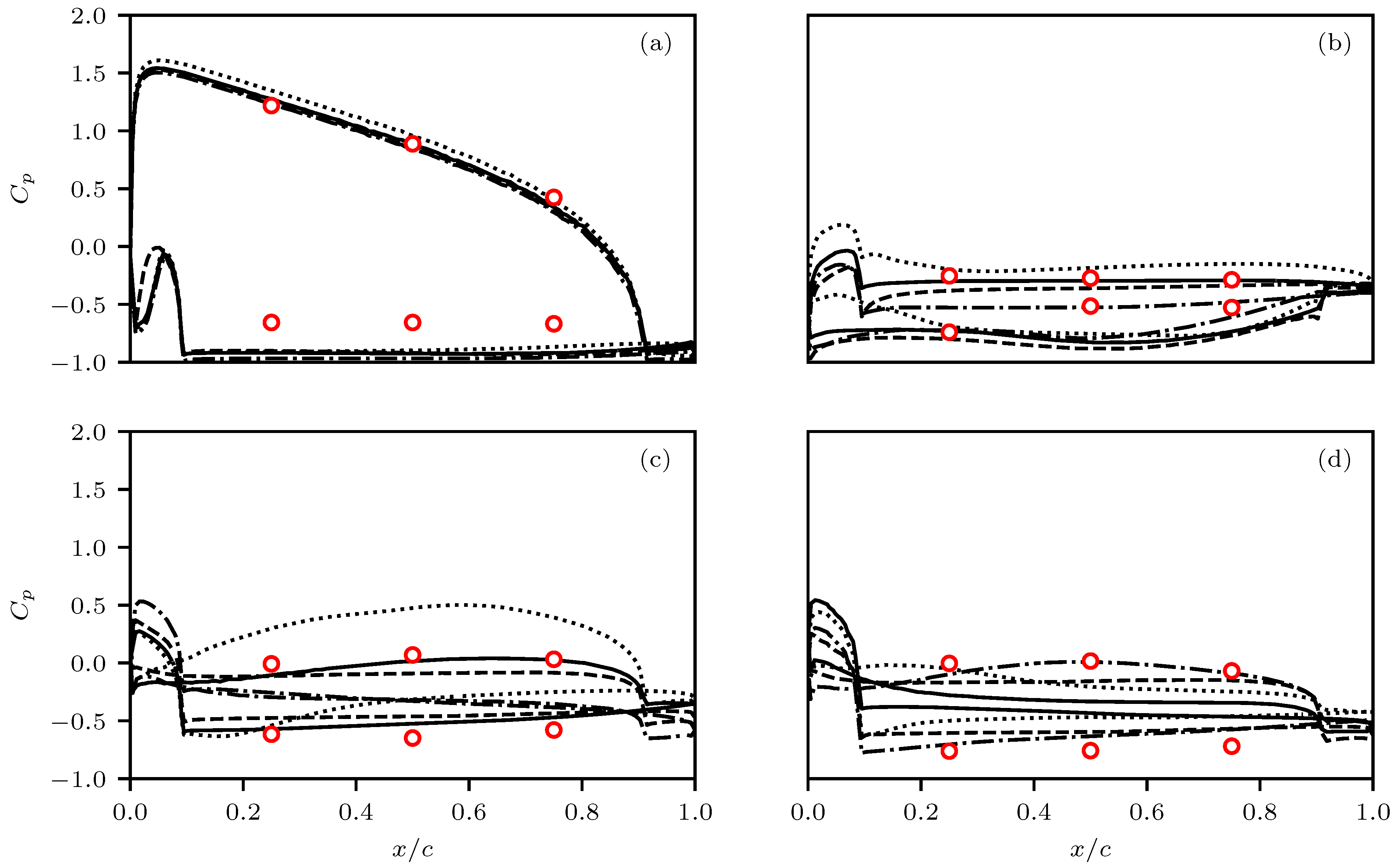
 ); SST k- (
); SST k- ( ); transition SST (
); transition SST ( ); and RSM (▪▪▪▪▪▪▪). Experimental k is shown as (•), while is referred as (▪). The vertical dimension is normalised with respect to the panel chord length c. The energy magnitude is normalised with respect to the power square of the inlet free-stream velocity measured in the wind tunnel.
); and RSM (▪▪▪▪▪▪▪). Experimental k is shown as (•), while is referred as (▪). The vertical dimension is normalised with respect to the panel chord length c. The energy magnitude is normalised with respect to the power square of the inlet free-stream velocity measured in the wind tunnel.
 ); SST k- (
); SST k- ( ); transition SST (
); transition SST ( ); and RSM (▪▪▪▪▪▪▪). Experimental k is shown as (•), while is referred as (▪). The vertical dimension is normalised with respect to the panel chord length c. The energy magnitude is normalised with respect to the power square of the inlet free-stream velocity measured in the wind tunnel.
); and RSM (▪▪▪▪▪▪▪). Experimental k is shown as (•), while is referred as (▪). The vertical dimension is normalised with respect to the panel chord length c. The energy magnitude is normalised with respect to the power square of the inlet free-stream velocity measured in the wind tunnel.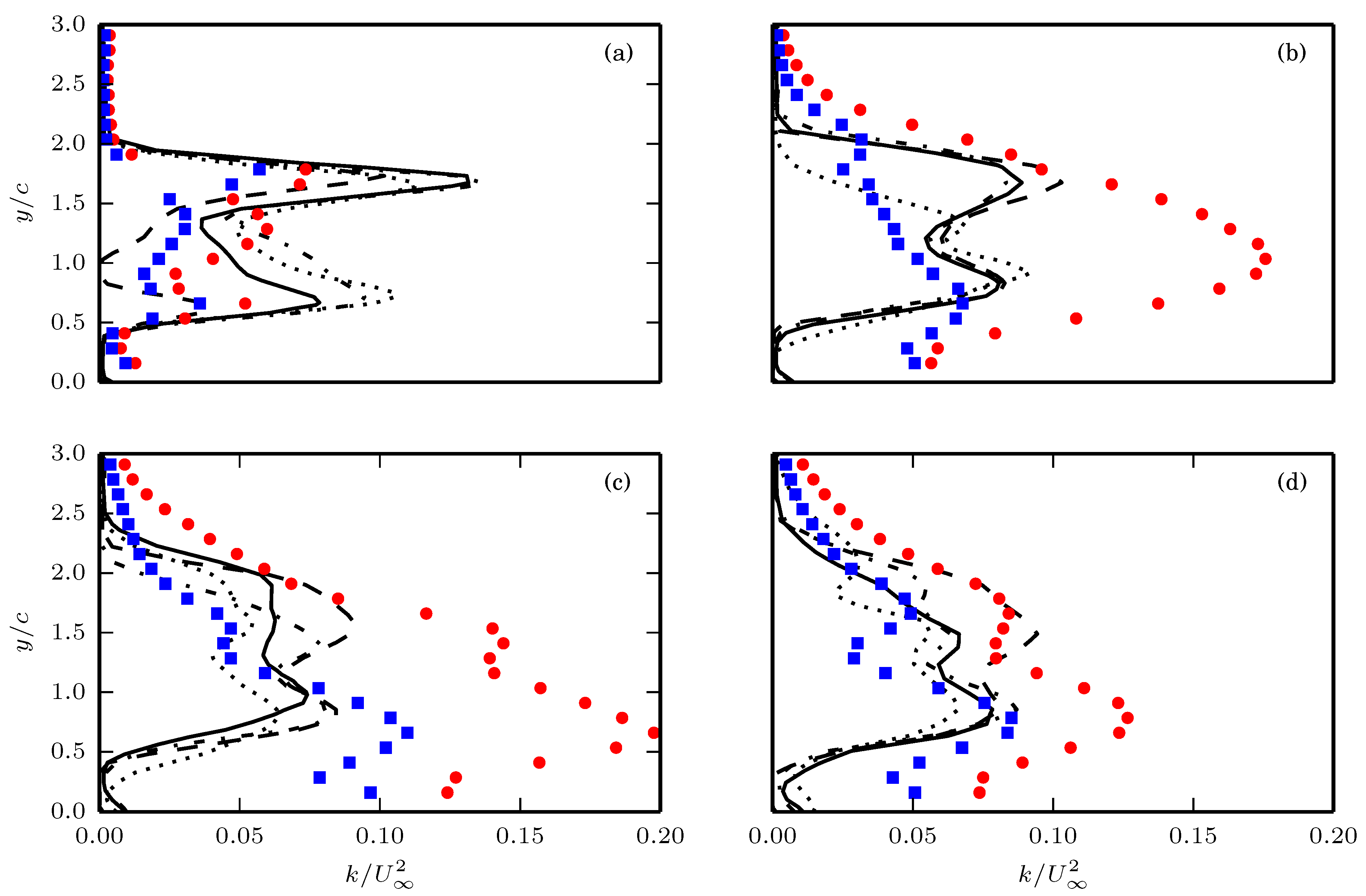
Publisher’s Note: MDPI stays neutral with regard to jurisdictional claims in published maps and institutional affiliations. |
© 2021 by the authors. Licensee MDPI, Basel, Switzerland. This article is an open access article distributed under the terms and conditions of the Creative Commons Attribution (CC BY) license (http://creativecommons.org/licenses/by/4.0/).
Share and Cite
Güemes, A.; Fajardo, P.; Raiola, M. Experimental Assessment of RANS Models for Wind Load Estimation over Solar-Panel Arrays. Appl. Sci. 2021, 11, 2496. https://doi.org/10.3390/app11062496
Güemes A, Fajardo P, Raiola M. Experimental Assessment of RANS Models for Wind Load Estimation over Solar-Panel Arrays. Applied Sciences. 2021; 11(6):2496. https://doi.org/10.3390/app11062496
Chicago/Turabian StyleGüemes, Alejandro, Pablo Fajardo, and Marco Raiola. 2021. "Experimental Assessment of RANS Models for Wind Load Estimation over Solar-Panel Arrays" Applied Sciences 11, no. 6: 2496. https://doi.org/10.3390/app11062496
APA StyleGüemes, A., Fajardo, P., & Raiola, M. (2021). Experimental Assessment of RANS Models for Wind Load Estimation over Solar-Panel Arrays. Applied Sciences, 11(6), 2496. https://doi.org/10.3390/app11062496






